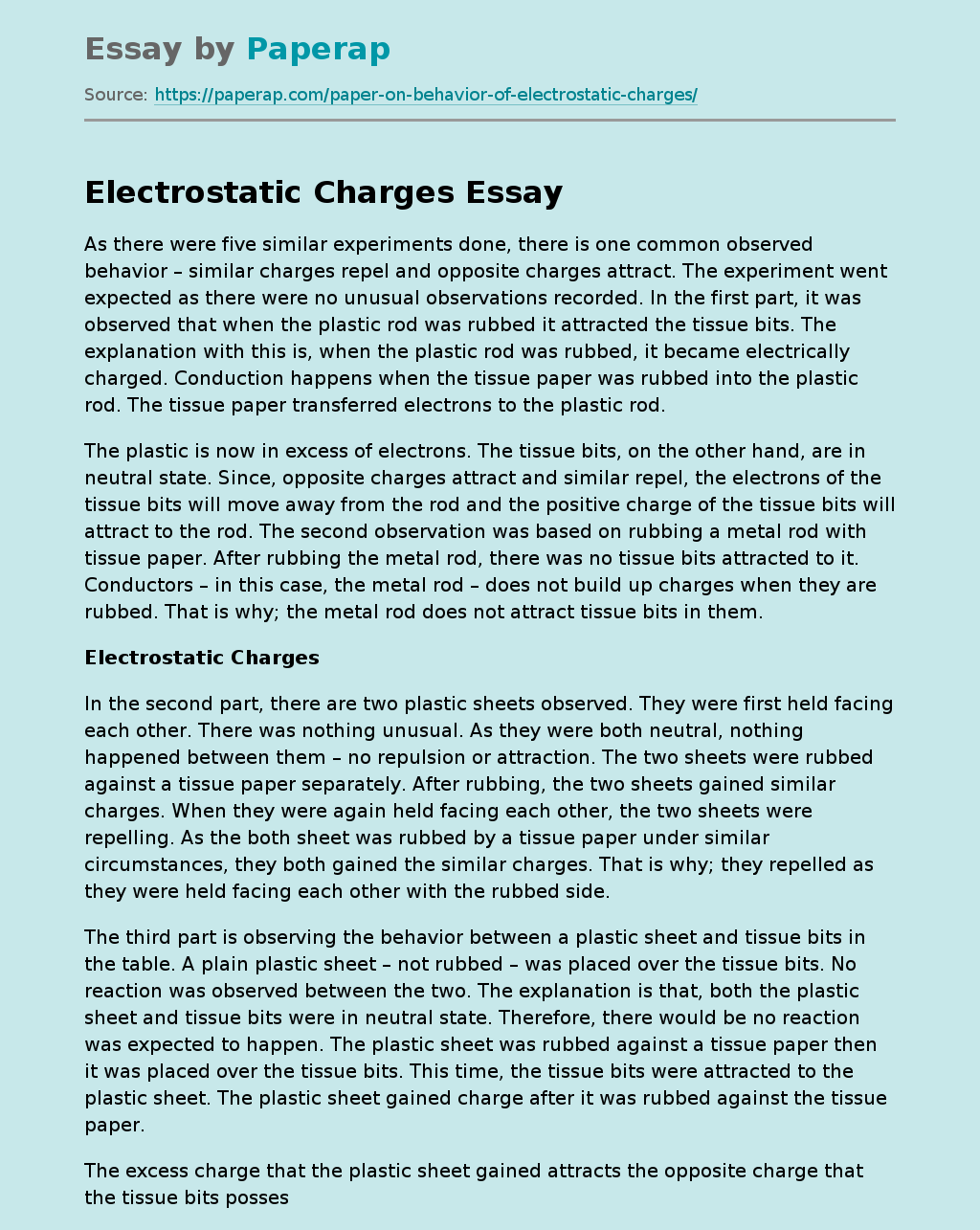Electrostatic Charges
As there were five similar experiments done, there is one common observed behavior – similar charges repel and opposite charges attract. The experiment went expected as there were no unusual observations recorded. In the first part, it was observed that when the plastic rod was rubbed it attracted the tissue bits. The explanation with this is, when the plastic rod was rubbed, it became electrically charged. Conduction happens when the tissue paper was rubbed into the plastic rod.
The tissue paper transferred electrons to the plastic rod.
The plastic is now in excess of electrons. The tissue bits, on the other hand, are in neutral state. Since, opposite charges attract and similar repel, the electrons of the tissue bits will move away from the rod and the positive charge of the tissue bits will attract to the rod. The second observation was based on rubbing a metal rod with tissue paper. After rubbing the metal rod, there was no tissue bits attracted to it.
Conductors – in this case, the metal rod – does not build up charges when they are rubbed. That is why; the metal rod does not attract tissue bits in them.
Electrostatic Charges
In the second part, there are two plastic sheets observed. They were first held facing each other. There was nothing unusual. As they were both neutral, nothing happened between them – no repulsion or attraction. The two sheets were rubbed against a tissue paper separately. After rubbing, the two sheets gained similar charges. When they were again held facing each other, the two sheets were repelling.
As the both sheet was rubbed by a tissue paper under similar circumstances, they both gained the similar charges. That is why; they repelled as they were held facing each other with the rubbed side.
The third part is observing the behavior between a plastic sheet and tissue bits in the table. A plain plastic sheet – not rubbed – was placed over the tissue bits. No reaction was observed between the two. The explanation is that, both the plastic sheet and tissue bits were in neutral state. Therefore, there would be no reaction was expected to happen. The plastic sheet was rubbed against a tissue paper then it was placed over the tissue bits. This time, the tissue bits were attracted to the plastic sheet. The plastic sheet gained charge after it was rubbed against the tissue paper.
The excess charge that the plastic sheet gained attracts the opposite charge that the tissue bits possess. It was then observed what will happen if there is an outside interference. As when the rubbed plastic sheet was placed over the tissue bits, a hand tried touching the rubbed area. It was observed that when the hand touches the rubbed area, the tissue bits placed near the hand was repelled. The reason is that the hand interferes with the electric field. The attraction between the charges of the tissue bits and the plastic sheet was blocked by the hand which rates a greater attraction between it and the plastic sheet.
In the fourth part, an electroscope was used. A plastic sheet was placed over the metal knob of the electroscope. Nothing happened because the plastic sheet is neutral so there would be no charge to be transferred. When a rubbed plastic sheet was rubbed over the electroscope, the two metal foils inside moved apart. The same thing was observed when the plastic sheet touched the metal knob. When the plastic sheet was placed near the metal knob, it was partially charged. That is why the foil inside repelled in a small distance compared when he plastic sheet touched the metal knob.
The last part includes a Van De Graff generator. As the cradle was rotated, the tissue pompoms stood up. As the crank was turned, it released charged. To clearly explain, figure 1 shows the inside of a Van De Graff generator. Figure 1. Parts of the Van De Graff generator. Photo taken from http://images. Horizontally. Com As the crank was rotated near the motor area, the rubber belt released charges. Negative charges were build up in the collecting crush area; leaving the positive charges in the metal sphere. This is the reason why the tissue pompoms stood up.
Electrostatic Charges. (2019, Dec 05). Retrieved from https://paperap.com/paper-on-behavior-of-electrostatic-charges/

